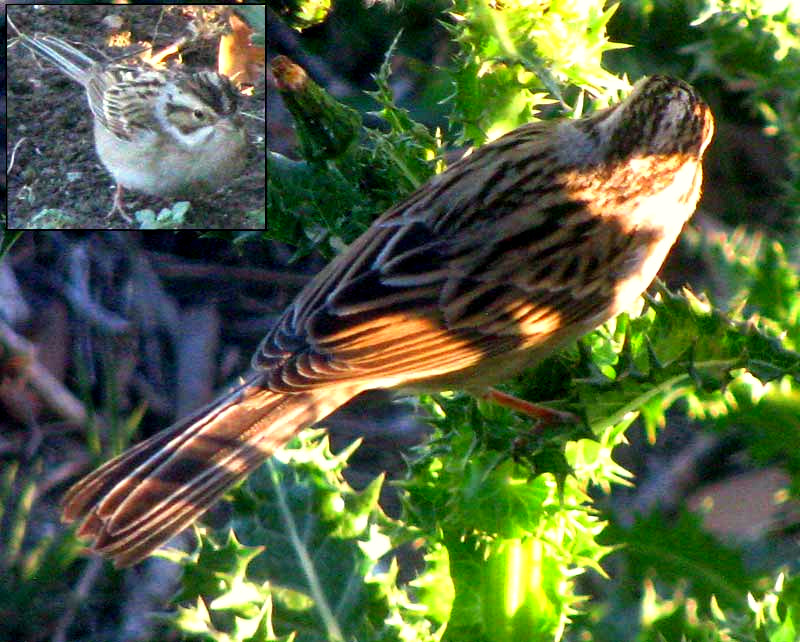Excerpts from Jim Conrad's
Naturalist Newsletter

from the March 31, 2013 Newsletter issued from the Frio Canyon Nature Education Center in northern Uvalde County, southwestern Texas, on the southern border of the Edwards Plateau; elevation ~1750m (~5750 ft); N29.62°, W99.86°; USA
CLAY-COLORED SPARROW
All winter so many Chipping Sparrows have wandered about the neighborhood in small to fairly large flocks that when I was washing dishes and a stripe-backed, plain-chested sparrow appeared foraging on the ground below the kitchen window I assumed it was one of them. However, this bird had a very conspicuous and well defined gray stripe through his crown, which Chipping Sparrows don't. That's him perched on a Prickly Sow Thistle, with an inset showing him hopping on the ground, above.
Besides the head stripe, this bird displayed a dark cheek patch completely surrounded by a whitish face. Immature Chipping Sparrows also have brown cheek patches, but not as well defined as this.
In short, this was a Clay-colored Sparrow, SPIZELLA PALLIDA, belonging to the same genus as the Chipping Sparrow and closely related to it. Birders in both eastern North America and most of the West normally don't see Clay-colored Sparrows in their regions because this is one of few bird species distributed nearly entirely in mid continent. It overwinters in Mexico and southern Texas, migrates through the central US grasslands, and nests in the north-central US states and south-central Canada.
You might be interested in the very striking and informative animated map displaying the Clay-colored Sparrow's migration route throughout the year, with the spring route shown taking a more easterly course than the fall one. That map indicates that at this time of year our part of southwestern Texas is "white hot" with concentrations of Clay-colored Sparrows crossing the border from Mexico and headed north. Then as the animation proceeds through summer, notice how the nesting population in the north-central states shifts to the west before beginning the fall trip back to Mexico. The map shows that during fall migration, much in contrast to now, our part of Texas sees few Clay-colored Sparrows, for the largest numbers return to Mexico via New Mexico and extreme western Texas, including the Big Bend area. Maps like this, based on observations by untold numbers of birders in the field, are revealing patterns of migration not hitherto realized.
Apart from this seasonal shift of migration route, Clay-colored Sparrows are known to be expanding their range eastward.
The species is known to flock with their Chipping Sparrow cousins, as well as with similar looking and closely related Brewer's Sparrows. All three species might be found here, and I suspect that I've been overlooking the Brewer's, distracted by all the Chipping Sparrows.
The Clay-colored Sparrow's primary habitat is described as isolated stands of shrubs and trees within a grassland matrix, though they also are known to turn up in open, dry coniferous forests, overgrown pastures, shelterbelts and even in suburban zones.